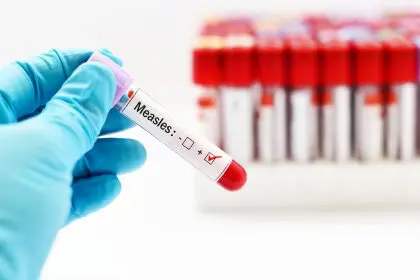A concerning new chapter in the ongoing COVID-19 pandemic has emerged as health officials track the rapid global spread of variant NB.1.8.1, a strain that has captured international attention due to its accelerated transmission patterns and unique genetic characteristics. This latest development serves as a stark reminder that the coronavirus continues to evolve and adapt, requiring continued vigilance from both medical professionals and the general public.
The emergence of NB.1.8.1 represents more than just another variant in the long list of COVID-19 mutations. Its swift rise from representing a mere fraction of global cases to becoming a significant portion of sequenced samples worldwide has prompted urgent monitoring efforts from health organizations across multiple continents. The variant’s ability to spread rapidly while carrying multiple concerning mutations has raised important questions about the future trajectory of the pandemic.
Medical experts emphasize that while NB.1.8.1 does not appear to cause more severe illness than previous variants, its rapid proliferation pattern demands serious attention. The strain’s genetic makeup includes several modifications that could potentially impact both transmissibility and the body’s immune response, making it a variant of particular interest for ongoing surveillance efforts.
Origins and rapid global expansion
The NB.1.8.1 variant first appeared on the radar of international health surveillance systems in late January 2025, emerging from the well-established Omicron JN.1 lineage that has dominated global COVID-19 cases in recent years. What makes this particular variant noteworthy is not just its genetic heritage but the remarkable speed at which it has established itself as a significant player in the global COVID-19 landscape.
World Health Organization data reveals a dramatic surge in NB.1.8.1 prevalence, with the variant accounting for 10.7 percent of all globally sequenced COVID cases during the week of April 21 through April 27. This represents a more than four-fold increase from the 2.5 percent prevalence recorded just one month earlier, demonstrating an exponential growth pattern that has captured the attention of epidemiologists worldwide.
The variant’s expansion has been particularly pronounced in certain regions, with China and Hong Kong experiencing the most significant concentrations of cases. However, the strain has demonstrated its ability to cross international borders with ease, establishing a presence in 22 countries across multiple continents. This global distribution pattern suggests that NB.1.8.1 possesses characteristics that make it highly adaptable to different populations and environmental conditions.
Current presence in the United States
Within the United States, NB.1.8.1 remains relatively uncommon, with fewer than 20 confirmed sequences identified through national surveillance systems. However, the pattern of detection provides important insights into how the variant is likely entering the country and where it might establish a foothold in coming weeks.
The majority of identified cases have been linked to international travelers, with detection occurring primarily at major international airports in California, Washington, Virginia, and New York City. This distribution pattern aligns with typical introduction pathways for new variants, which often arrive through international travel hubs before spreading to surrounding communities.
Health officials emphasize that the current low numbers should not be interpreted as a reason for complacency. Historical patterns with previous variants have shown that initial detections among international travelers often precede broader community transmission. The variant’s rapid global spread suggests that increased prevalence in the United States may be only a matter of time.
Symptom profile and clinical presentation
One of the more reassuring aspects of current NB.1.8.1 surveillance data is that the variant does not appear to cause more severe illness than its predecessors. Patients infected with NB.1.8.1 typically experience symptoms that align closely with those seen in other recent COVID-19 variants, providing some continuity for both patients and healthcare providers.
The primary symptoms associated with NB.1.8.1 include the familiar constellation of COVID-19 manifestations that have become well-recognized over the past several years. Fever remains a common presentation, often accompanied by chills that can range from mild temperature fluctuations to more pronounced episodes that leave patients feeling distinctly unwell.
Respiratory symptoms continue to play a central role in NB.1.8.1 infections, with persistent coughing being one of the most frequently reported complaints. This cough may begin as a minor throat irritation but can progress to become more persistent and disruptive to daily activities. Sore throat symptoms often accompany the cough, creating discomfort that patients describe as ranging from mild scratchiness to significant pain that interferes with swallowing.
Nasal congestion represents another prominent feature of NB.1.8.1 infections, with many patients experiencing stuffiness that can affect sleep quality and overall comfort levels. This congestion may be accompanied by other upper respiratory symptoms that contribute to an overall feeling of being unwell.
Fatigue continues to be a significant component of the NB.1.8.1 symptom profile, with many patients reporting energy levels that are substantially lower than their normal baseline. This fatigue can range from mild tiredness to profound exhaustion that makes routine activities feel overwhelming.
More concerning respiratory symptoms, including difficulty breathing, have been reported in some cases, though these appear to occur at rates similar to other recent variants. Additionally, gastrointestinal symptoms such as diarrhea have been documented, reflecting the virus’s continued ability to affect multiple organ systems.
Genetic mutations and transmission characteristics
The NB.1.8.1 variant carries six distinct spike protein mutations that distinguish it from its ancestral strains, and these genetic changes have important implications for both transmissibility and immune evasion potential. Spike proteins serve as the key mechanism through which coronaviruses attach to and enter human cells, making any mutations in this region particularly significant for understanding variant behavior.
These mutations appear to enhance the variant’s ability to spread from person to person, with preliminary data suggesting that NB.1.8.1 may be slightly more transmissible than many of its recent predecessors. This increased transmissibility could help explain the variant’s rapid rise in global prevalence and its ability to establish itself in diverse geographic regions.
The mutations also raise questions about the variant’s ability to evade existing antibodies, whether those antibodies were generated through vaccination or previous infection. However, experts maintain cautious optimism that existing immunity should provide some level of protection against severe outcomes, even if it may be less effective at preventing infection entirely.
Vaccine effectiveness and protection strategies
Current evidence suggests that existing vaccines continue to provide meaningful protection against NB.1.8.1, particularly in preventing severe illness, hospitalization, and death. While the variant’s mutations may reduce vaccine effectiveness somewhat, the broad-based immune response generated by current vaccines appears to retain significant protective capacity.
Healthcare experts emphasize that individuals who have received recent COVID-19 vaccinations or boosters likely maintain some level of protection against NB.1.8.1. However, the degree of protection may vary based on factors such as time since last vaccination, individual immune system characteristics, and overall health status.
New COVID-19 booster shots from major vaccine manufacturers including Pfizer, Moderna, and Novavax are anticipated to become available in early fall, with preliminary data suggesting these updated formulations will be effective against NB.1.8.1 and other circulating strains. These updated vaccines are being designed to address the genetic changes seen in recent variants, potentially providing enhanced protection against current and emerging strains.
Ongoing health impact and surveillance efforts
Despite the attention focused on new variants, COVID-19 continues to represent a significant public health challenge in the United States and globally. Current data indicates that the virus still causes approximately 300 deaths each week in the United States alone, underscoring the importance of continued vigilance and protective measures.
Health surveillance systems are working around the clock to monitor NB.1.8.1 and other emerging variants, tracking their spread patterns, clinical characteristics, and potential impact on vaccine effectiveness. This ongoing monitoring effort represents a crucial component of pandemic preparedness and response efforts.
Protective measures and recommendations
Healthcare experts continue to emphasize the importance of basic preventive measures that have proven effective throughout the pandemic. Regular hand washing remains one of the most fundamental and effective strategies for reducing COVID-19 transmission risk, regardless of which variant may be circulating in a given area.
Individuals who feel unwell are strongly encouraged to stay home and wear masks when around others to prevent potential transmission. This recommendation applies regardless of whether symptoms seem mild or severe, as COVID-19 can present with a wide range of symptom intensities.
Proper respiratory etiquette, including covering coughs and sneezes with the elbow rather than hands, continues to represent an important strategy for reducing droplet transmission. These simple behavioral modifications can significantly impact community transmission rates when practiced consistently across populations.
Special considerations for vulnerable populations
Certain groups remain at elevated risk for severe COVID-19 outcomes, regardless of which variant may be causing their infection. Older adults, individuals with compromised immune systems, and those with underlying health conditions such as diabetes, heart disease, or respiratory conditions should take particular care to avoid exposure and seek prompt medical attention if symptoms develop.
For these vulnerable populations, the emergence of NB.1.8.1 serves as an important reminder to maintain protective behaviors and stay current with vaccination recommendations. Healthcare providers may recommend additional precautions for high-risk individuals, particularly during periods of increased community transmission.
Looking ahead: adaptation and preparedness
The emergence and rapid spread of NB.1.8.1 reinforces the reality that COVID-19 continues to evolve and adapt, requiring ongoing flexibility and preparedness from both individuals and healthcare systems. While this latest variant does not appear to represent a dramatic shift in disease severity, its rapid proliferation demonstrates the virus’s continued capacity for change.
Moving forward, experts emphasize the importance of maintaining robust surveillance systems, continuing vaccine development efforts, and preserving public health infrastructure capable of responding to emerging variants. The lessons learned from tracking and responding to NB.1.8.1 will undoubtedly inform future pandemic preparedness efforts and variant response strategies.
As communities continue to navigate the evolving COVID-19 landscape, staying informed about emerging variants while maintaining proven protective behaviors remains the most effective strategy for minimizing risk and protecting both individual and community health.















